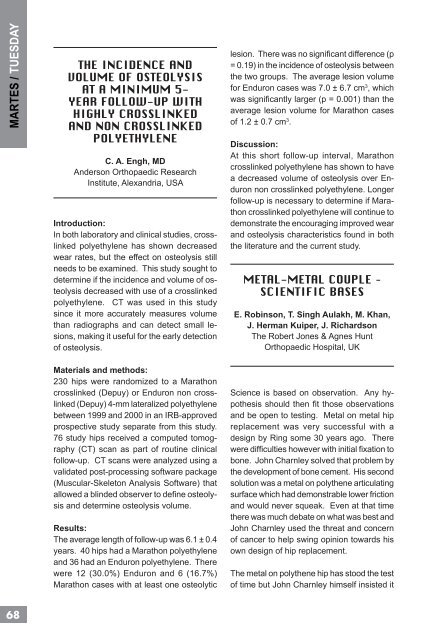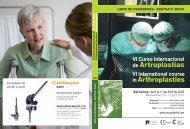cadera / hip - Active Congress.......
cadera / hip - Active Congress.......
cadera / hip - Active Congress.......
Create successful ePaper yourself
Turn your PDF publications into a flip-book with our unique Google optimized e-Paper software.
MARTES / TUESDAY<br />
68<br />
THE INCIDENCE AND<br />
VOLUME OF OSTEOLYSIS<br />
AT A MINIMUM 5-<br />
YEAR FOLLOW-UP WITH<br />
HIGHLY CROSSLINKED<br />
AND NON CROSSLINKED<br />
POLYETHYLENE<br />
C. A. Engh, MD<br />
Anderson Orthopaedic Research<br />
Institute, Alexandria, USA<br />
Introduction:<br />
In both laboratory and clinical studies, crosslinked<br />
polyethylene has shown decreased<br />
wear rates, but the effect on osteolysis still<br />
needs to be examined. This study sought to<br />
determine if the incidence and volume of osteolysis<br />
decreased with use of a crosslinked<br />
polyethylene. CT was used in this study<br />
since it more accurately measures volume<br />
than radiographs and can detect small lesions,<br />
making it useful for the early detection<br />
of osteolysis.<br />
Materials and methods:<br />
230 <strong>hip</strong>s were randomized to a Marathon<br />
crosslinked (Depuy) or Enduron non crosslinked<br />
(Depuy) 4-mm lateralized polyethylene<br />
between 1999 and 2000 in an IRB-approved<br />
prospective study separate from this study.<br />
76 study <strong>hip</strong>s received a computed tomography<br />
(CT) scan as part of routine clinical<br />
follow-up. CT scans were analyzed using a<br />
validated post-processing software package<br />
(Muscular-Skeleton Analysis Software) that<br />
allowed a blinded observer to defi ne osteolysis<br />
and determine osteolysis volume.<br />
Results:<br />
The average length of follow-up was 6.1 ± 0.4<br />
years. 40 <strong>hip</strong>s had a Marathon polyethylene<br />
and 36 had an Enduron polyethylene. There<br />
were 12 (30.0%) Enduron and 6 (16.7%)<br />
Marathon cases with at least one osteolytic<br />
lesion. There was no signifi cant difference (p<br />
= 0.19) in the incidence of osteolysis between<br />
the two groups. The average lesion volume<br />
for Enduron cases was 7.0 ± 6.7 cm 3 , which<br />
was signifi cantly larger (p = 0.001) than the<br />
average lesion volume for Marathon cases<br />
of 1.2 ± 0.7 cm 3 .<br />
Discussion:<br />
At this short follow-up interval, Marathon<br />
crosslinked polyethylene has shown to have<br />
a decreased volume of osteolysis over Enduron<br />
non crosslinked polyethylene. Longer<br />
follow-up is necessary to determine if Marathon<br />
crosslinked polyethylene will continue to<br />
demonstrate the encouraging improved wear<br />
and osteolysis characteristics found in both<br />
the literature and the current study.<br />
METAL-METAL COUPLE –<br />
SCIENTIFIC BASES<br />
E. Robinson, T. Singh Aulakh, M. Khan,<br />
J. Herman Kuiper, J. Richardson<br />
The Robert Jones & Agnes Hunt<br />
Orthopaedic Hospital, UK<br />
Science is based on observation. Any hypothesis<br />
should then fi t those observations<br />
and be open to testing. Metal on metal <strong>hip</strong><br />
replacement was very successful with a<br />
design by Ring some 30 years ago. There<br />
were diffi culties however with initial fi xation to<br />
bone. John Charnley solved that problem by<br />
the development of bone cement. His second<br />
solution was a metal on polythene articulating<br />
surface which had demonstrable lower friction<br />
and would never squeak. Even at that time<br />
there was much debate on what was best and<br />
John Charnley used the threat and concern<br />
of cancer to help swing opinion towards his<br />
own design of <strong>hip</strong> replacement.<br />
The metal on polythene <strong>hip</strong> has stood the test<br />
of time but John Charnley himself insisted it





